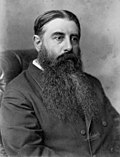A request that this article title be changed to 1884 Stout–Vogel ministry is under discussion . Please do not move this article until the discussion is closed. |
The First Stout-Vogel Ministry was a responsible government in New Zealand lasting less than a fortnight, not to be confused with the longer-lasting Second Stout-Vogel Ministry. [1] It took office after the Continuous Ministry of Harry Atkinson fell to a confidence motion after the 1884 general election.







